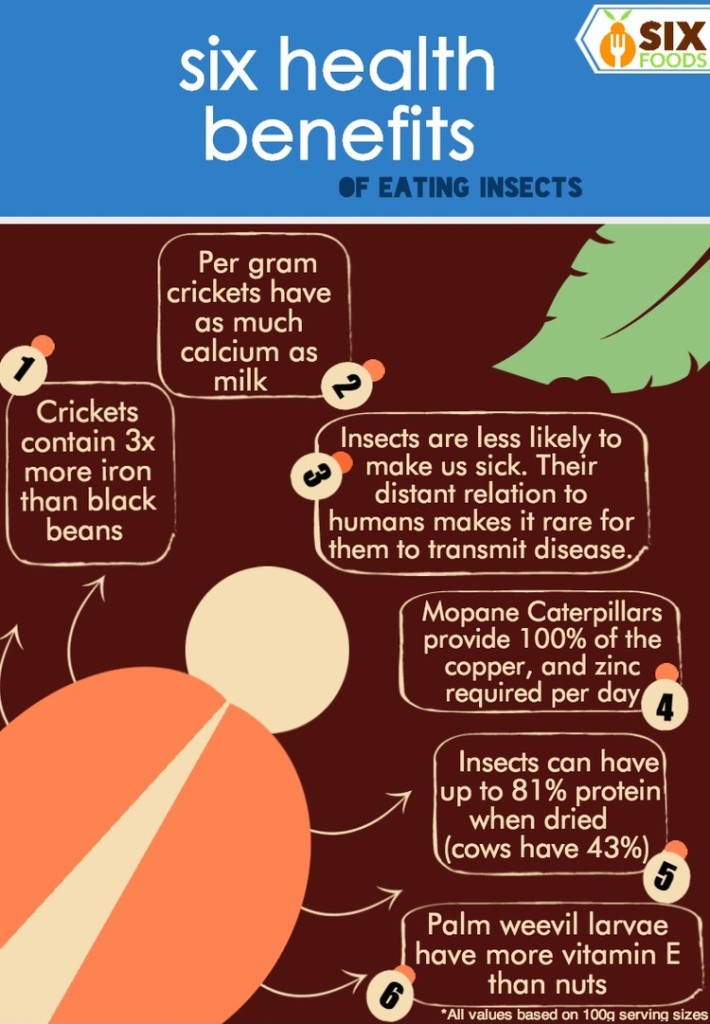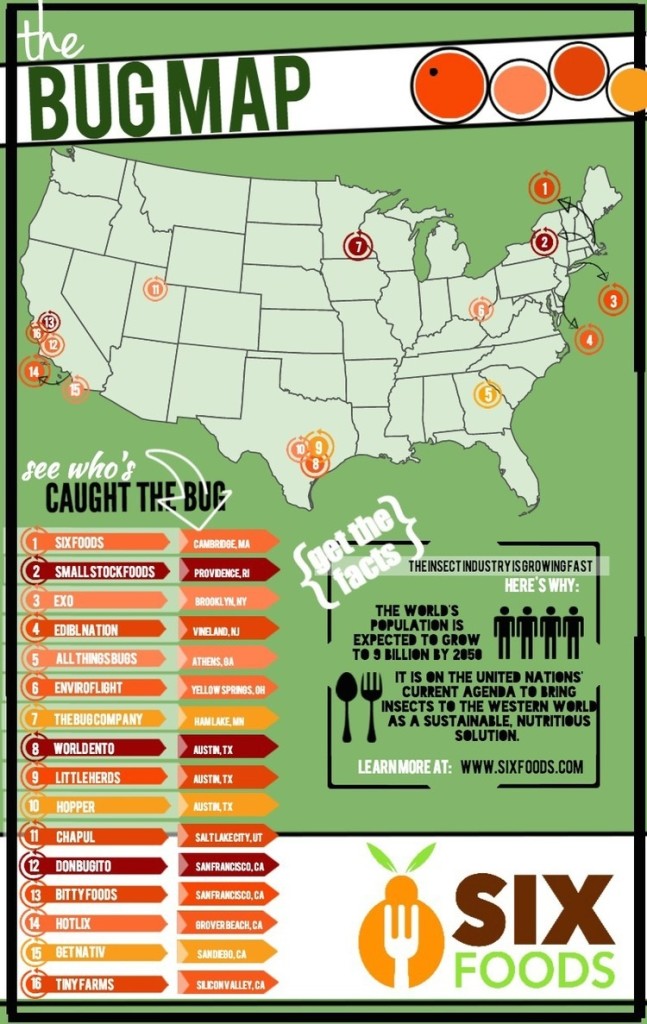A growing number of start-ups are finding an expanding market for an unlikely new protein. But is mainstream America finally ready for the six-legged food revolution?
It’s 4:50 p.m., ten minutes until the post office closes, and Laura D’Asaro is hustling down a side street in Cambridge, Massachusetts as fast as possible while pushing a hand trolley loaded up to her chest with towers of shrink-wrapped cardboard boxes. It’s a trip both hectic and familiar; every day D’Asaro visits the warehouse of her new company, Six Foods, to print out labels and pack up orders of its signature snack chip: Chirps. From there, it’s a short scramble to the gatekeepers of standard shipping and the Chirps are on their way to co-ops, natural food stores and personal residences all over the United States. What gives her the energy to do all the grunt work required of a new start-up while plotting the next great paradigm shift in American eating? Probably the same thing that powers her Chirps — cricket power. Or rather, cricket powder.
 The first time D’Asaro intentionally ate a bug was in Tanzania. She was walking down the road when she came upon a woman off to the side selling fried caterpillars. Having been an on-again, off-again vegetarian on account of her opposition to the inhumane practices of factory farming and its environmental impacts, D’Asaro had always found it easy to turn down strange meats on ethical grounds. But she’d never considered how she felt about insects. So because she didn’t have a good reason to say no, she gave them a shot. When she bit down, the taste of lobster flooded her mouth. “All I could think was ‘wow!’” she said, recalling the incident.
The first time D’Asaro intentionally ate a bug was in Tanzania. She was walking down the road when she came upon a woman off to the side selling fried caterpillars. Having been an on-again, off-again vegetarian on account of her opposition to the inhumane practices of factory farming and its environmental impacts, D’Asaro had always found it easy to turn down strange meats on ethical grounds. But she’d never considered how she felt about insects. So because she didn’t have a good reason to say no, she gave them a shot. When she bit down, the taste of lobster flooded her mouth. “All I could think was ‘wow!’” she said, recalling the incident.
When her study abroad program was over she returned to Harvard, but she couldn’t get those caterpillars out of her head. She started researching entomophagy (the eating of insects) and the more she learned the more excited she became. It turns out; you can raise insects quite easily without antibiotics or growth hormones, because they naturally thrive in small, contained spaces in the wild, unlike other domesticated livestock species. And because they’re cold-blooded, crickets and other edible insects can be harvested humanely by freezing. Basically, they get cold, go to sleep, and never wake up. No slaughterhouses or kill floors necessary. All of this was intriguing to D’Asaro. “I kept thinking, ‘Could this be a sustainable protein source that I can feel good about?’”
Around the same time that D’Asaro was discovering the upsides to a bug-based diet, the rest of the Western world was about to have the same epiphany. In 2013, the Food and Agriculture Organization of the United Nations released a report pleading a case for edible insects as an answer to our increasingly food-insecure world. It’s estimated that current food production will need to double by 2050 to feed the 9 billion humans who will not only need to eat, but who are also increasingly eating more meat. Edible insects (such as termites, crickets, some species of caterpillar and the palm weevil) are highly nutritious. They provide protein and vitamin content comparable to fish and lean meats, and they require a fraction of the resources required to raise livestock. Compare them to beef. It takes 2,000 gallons of water to produce enough beef for just four quarter-pounders. That same amount of cricket meat can be achieved with one gallon of water. And beef production creates nearly 3,000 times more greenhouse gas emissions than cricket farms. “It’s orders of magnitude better than anything we’ve got out there,” said D’Asaro. “But if people aren’t eating them, it’s not going to matter.”
Most of the world has been comfortable with putting insects on the dinner table ever since homo sapiens came down from the trees and built tables on which to eat dinner. Nearly two billion people in regions such as Central Africa and Southeast Asia regularly eat insects, the FAO report noted. The most popular varieties eaten worldwide are beetles, caterpillars, bees, wasps and ants. But only in the past few years has the idea gained any traction in Western countries. A research paper due out this fall in Food Quality and Preference suggests that the main problem keeping bugs from going mainstream is simple: Westerners don’t see them as pleasurable to eat.
“Appealing to consumer’s reason and responsibility…is likely to reinforce a dilemma in the mind of consumers,” write the authors. “Many know they can, in principle, eat insects, and perhaps that they should eat some, but very few are willing to eat them.”
D’Asaro and her college roommate and Six Foods co-founder Rose Wang encountered this psychological inconsistency firsthand at the Harvard Innovation Lab when they showed up for a pitch competition. It was a start-up weekend, where teams worked on ideas for ventures and then presented them to a panel of judges, and then received feedback on their proposals. D’Asaro and Wang brought with them 40 mealworm tacos they had made by processing the insects so they looked like ground meat. They were new to the collaborative space, and since they were the last group to go, they put the tacos in the fridge in the community section until their turn came. They didn’t label them. When they came back half an hour later, 35 of the tacos were gone, gobbled up by other competition participants who kept going back for more. But when D’Asaro and Wang put the five remaining tacos in front of the judges and told them what the main ingredient was, their faces dropped. They weren’t having any of it.
 “That’s when we pivoted toward crickets dried and milled into a flour that’s 70 percent protein,” said D’Asaro. The experience had driven home something they had been slow to learn: people weren’t ready to eat bugs in their natural state. At the beginning of their experimentations, they ordered any kind of insect they could get their hands on. Boxes of waxworms and mealworms and hornworms started arriving at their Harvard dorm room before getting cooked up and served at dinner parties to hesitant guests. After one friend fell out of his chair upon learning the main ingredient, they started trying to hide it, by toasting, roasting, chopping and grinding. “We tried cookies and chips, and people just kept eating the chips,” said D’Asaro. “It’s all about the form. That’s how American food culture works. We don’t eat anything whole. Imagine a whole chicken on the dinner table; people would freak. So for us, it’s all about conforming insects to preexisting food culture in America.”
“That’s when we pivoted toward crickets dried and milled into a flour that’s 70 percent protein,” said D’Asaro. The experience had driven home something they had been slow to learn: people weren’t ready to eat bugs in their natural state. At the beginning of their experimentations, they ordered any kind of insect they could get their hands on. Boxes of waxworms and mealworms and hornworms started arriving at their Harvard dorm room before getting cooked up and served at dinner parties to hesitant guests. After one friend fell out of his chair upon learning the main ingredient, they started trying to hide it, by toasting, roasting, chopping and grinding. “We tried cookies and chips, and people just kept eating the chips,” said D’Asaro. “It’s all about the form. That’s how American food culture works. We don’t eat anything whole. Imagine a whole chicken on the dinner table; people would freak. So for us, it’s all about conforming insects to preexisting food culture in America.”
Some anthropologists ascribe the Western aversion to insects as an unconscious rejection of anything considered “primitive.” Others posit that insects have never been competitive as food items in Europe or North America because domesticated crops and livestock offered much more dependable supplies. Still others wonder if, as crops and agriculture became more important than wild foods, insects became viewed primarily as a threat rather than a resource. The “ick” factor may have evolved in the West over many hundreds of years, but it has continued to be perpetuated in modern popular culture by shows like Fear Factor, that dared contestants to eat insects for prize money. Yet, as our worldview continues to grow more connected and globalized every day, the collective Western consciousness (as far as bug-eating is concerned) is slowly beginning to change.
When D’Asaro, Wang and their third co-founder, designer Meryl Natow, launched a Kickstarter campaign last year to test the waters for SixFoods, they were blown away. They met their goal of $30,000 in just three days and eventually raised more than twice that, becoming one of the most funded food campaigns ever. Crowdfunding has allowed a space for aspiring start-ups to connect directly to an audience especially receptive to their message. Since 2012, more than 30 start-ups specializing in crickets have launched in North America, with new ones cropping up almost every day. Most sell cricket meals and flours, or products made from it, including granola bars, chips, crackers, cookies, chocolates and dog treats. One company, called Critter Bitters is even extracting roasted crickets into bitters for craft cocktails. And with gluten-free and low-carb diets on the rise, it’s no wonder that the influential restaurant consultants Baum and Whiteman forecasted that insect protein powder would be among the hottest food and drink trends of 2015.
The success that SixFoods has seen in its first year of production would certainly suggest that people are taking that trend seriously. D’Asaro, Wang and Natow just sold their first 10,000 bags of cricket chips (available in a few stores in Cambridge and Seattle and online through Amazon and the SixFoods website). They are currently in the certification phase of getting Chirps into Whole Foods and, once all the paperwork goes through, they’ll have the first cricket product in a national chain grocery store. They’re also in the process of expanding operations to the West Coast, where they are adding another manufacturing facility and where their new headquarters will be. And right now they’re also finalists in the Echoing Green Fellowship, a national award that provides seed-stage funding to emerging leaders tackling social and environmental issues. But even if that does comes through, the ladies of SixFoods have their sights set on something bigger than just a better, healthier Dorito.
“Normalizing eating insects is just the first step,“ said D’Asaro. “We want to move from insects as an ingredient to insects more as a meat alternative.” She went on to tell a story about one of her African Studies professors who had grown up in Uganda, where grasshoppers, called “nsenene,” were considered a local delicacy. When he came to Harvard, he was at his first big banquet and they served shrimp, something he’d never eaten. And it was scary for him, but he didn’t want to be rude at his first big function. So he just kept telling himself, “It’s just a sea grasshopper.“
“And that’s exactly what we’re calling grasshoppers,” said D’Asaro. “Landshrimps. It’s a complete cultural flip. But I really do believe it’s possible.”
By Megan Molteni for The Riviter Magazine
Women Of Green needs YOUR voice to be part of the conversation. We encourage your comments and questions below, on facebook/womenofgreen, and on twitter/womenofgreen. Say It and Share It! We’re here to Turn Up The Volume!

